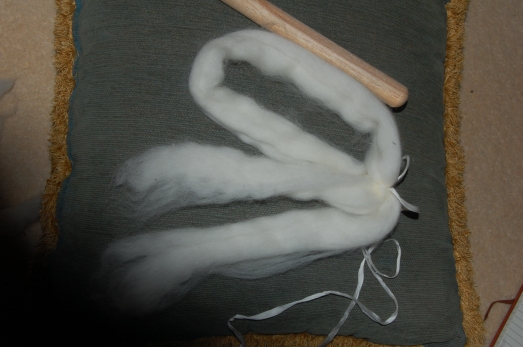When I started I was using a carved wooden dowel with a bunch of hairties as a whorl.
What am I using these days?
I’m using spindle sticks from here. They are fantastic! I’m not too good at making my own so these are perfect. They have a tapered end so with each twirl of my fingers the spindle turns several times. Also when I spin it I can get a nice fast spin. I have seven and I’m buying more (so I have plenty to let others use and have a try at spinning at living history events. No, seven is not enough to do that with. Factor two to spin wool spindles with and one to ply them onto and the same for flax only gives me one spare.)
You can see the spindle stick here with three whorls. The right (top) of the spindle stick is darker because its absorbed the oil from my fingers as I’ve been using it. The corners on the top are starting to round and the stripe just above the whorl is where my handmade whorl sits. I tend to swap from my heavy whorl to my lightest to no whorl at all as I build up the cop.
My whorls. The top left is one I bought from flaming gargoyle pottery at a medieval tournament. I was so busy at the event I didn’t get time to go shopping but one of our newer members told me they saw some whorls for sale and so on the last day when I went to get my first real coffee for three days right when the stalls were packing up (in the rain) I ran and found the stall. I bought three, their biggest, their smallest and one in between. The one pictured is the smallest.
The top right I’ve made myself and is significantly thicker in the middle and quite thin at the edges. This is my lightest whorl.
The bottom is from the reproduction spindle at The Woolery. It comes with a notched stick that I find useless. You can’t hold it out to the side of your distaff as the thread doesn’t stay in the horizontal notch and the top is so fat that every turn of your fingers only turns the spindle once. It works great as a drop spindle but the whorl spins it short and FAST. Like, REAL fast. Like, I couldn’t even start drafting before it went into backspin fast.
But for the style of spinning I’m doing the whorl works fantastic. Not surprising as it was based on medieval whorls and I’m trying to reproduce medieval spinning. This whorl is my heaviest. Unfortunatly, as fantastic as it is, because there is very little (almost no) taper in the hole it doesn’t stay too well on my spindle. I can wedge it on with a splinter of wood or wrap some yarn around the base of it to keep it on. It’s new so I haven’t experemented with it much yet.
Costs? Spindle sticks are seven euro.
The Flaming Gargoyle whorl was three for $10 (they were $4 each but they only asked $10 for the three without me even bartering. 🙂 )
My whorl was essentially free as I’ve had the clay lying around for years. Can’t remember how much the clay was but you can make a LOT of whorls from it so even factoring the cost of the clay into account it would by FAR be the cheapest.
The whorl from the Woolery was $17 plus postage from America (postage from America always seems more expensive than postage from anywhere else and often takes twice as long to arrive). Yes, that was for a complete spindle but as I said, I can’t use the stick.
My go-to whorl is the one from Flaming Gargoyle. I use my homemade one when the cop gets heavier then I just take the whorl off when I no longer need it. As I said, I haven’t had the one from the woolery long enough to do much spinning with but I wouldn’t want to use it walking around a reenactment event as I can see it slipping off and getting lost (and being dug up by archaeologists in years to come, lol).
What I really want is a whorl just like the one from the woolery, without the stick (I have perfect ones already) that has a tapered hole. Anyone got any sources?
So that’s what I’m spinning with now days.
















